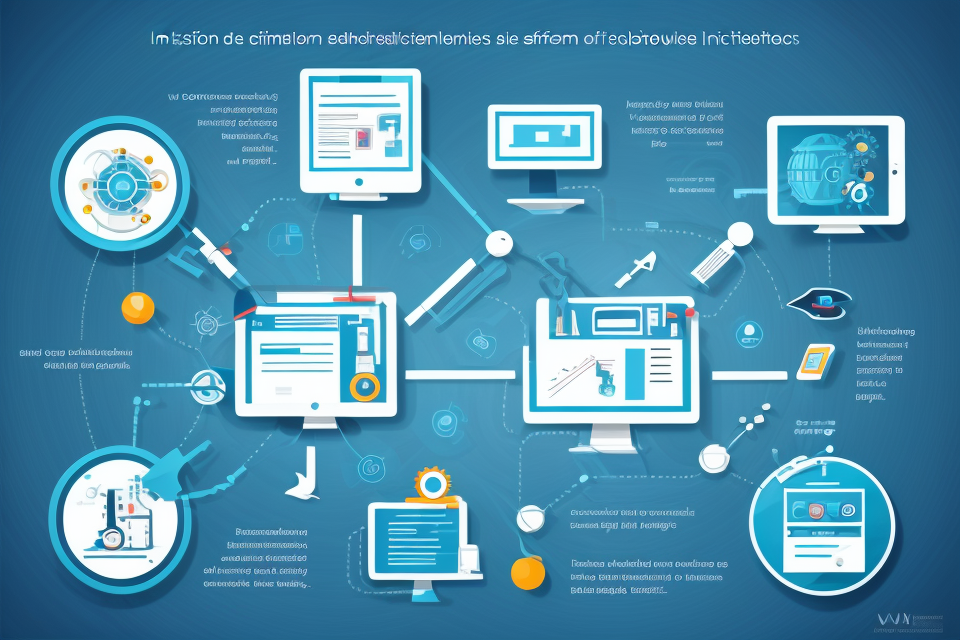
Artificial Intelligence (AI) has been a game-changer in the world of technology. From self-driving cars to virtual assistants, AI has made its way into our daily lives. But have you ever wondered how AI works? In this article, we will delve into the inner mechanics of AI and understand how it enables machines to simulate human intelligence. Get ready to explore the fascinating world of AI and discover how it transforms the way we live and work.
Understanding the Basics of AI
Machine Learning: The Cornerstone of AI
Machine learning is a type of artificial intelligence that allows systems to learn and improve from experience without being explicitly programmed. It is a subfield of computer science that uses statistical techniques to give computers the ability to learn from data. The primary goal of machine learning is to build systems that can learn and make predictions or decisions based on data.
Supervised Learning
Supervised learning is a type of machine learning in which the system is trained on labeled data. The goal is to learn a mapping between input features and output labels. This type of learning is commonly used in classification and regression tasks. For example, a supervised learning algorithm might be trained on a dataset of images labeled with their corresponding object classes.
Unsupervised Learning
Unsupervised learning is a type of machine learning in which the system is trained on unlabeled data. The goal is to learn the underlying structure of the data. This type of learning is commonly used in clustering and dimensionality reduction tasks. For example, an unsupervised learning algorithm might be trained on a dataset of customer data and cluster the customers based on their purchasing habits.
Reinforcement Learning
Reinforcement learning is a type of machine learning in which the system learns by interacting with an environment. The goal is to learn a policy that maximizes a reward signal. This type of learning is commonly used in robotics and game playing. For example, a reinforcement learning algorithm might be trained to play a game by learning which actions lead to the highest rewards.
Neural Networks: The Building Blocks of AI
Neural networks are the foundation of artificial intelligence and serve as the core components in the development of AI systems. They are inspired by the structure and function of biological neural networks in the human brain.
Artificial neurons, also known as nodes or units, are the basic building blocks of neural networks. They receive input signals, process them, and produce output signals. Each neuron is connected to other neurons, forming complex networks that enable the system to learn and make predictions.
Layers are another essential aspect of neural networks. They represent different levels of abstraction in the data and are arranged in a hierarchical structure. Each layer processes the input data and passes it on to the next layer until the output is produced. The number of layers and their complexity can vary depending on the specific application of the neural network.
Activation functions are responsible for introducing non-linearity into the neural network, allowing it to learn and model complex relationships in the data. They determine whether a neuron should fire or not based on the weighted sum of its inputs and a threshold value. Common activation functions include the sigmoid, ReLU (Rectified Linear Unit), and tanh (hyperbolic tangent) functions.
In summary, neural networks are the building blocks of AI and are responsible for enabling the system to learn and make predictions. They consist of artificial neurons, layers, and activation functions, which work together to process input data and produce output. Understanding the inner workings of neural networks is crucial for developing advanced AI systems that can perform complex tasks and make accurate predictions.
AI in Practice: Real-World Applications
Computer Vision
Image Recognition
Image recognition is a key component of computer vision, enabling machines to analyze and understand visual data. This technology is utilized in various applications, such as object detection, facial recognition, and scene understanding. It involves the extraction of relevant features from images, followed by the comparison of these features to a database of known objects or patterns. Deep learning algorithms, particularly convolutional neural networks (CNNs), have significantly advanced image recognition capabilities, enabling machines to accurately identify objects and scenes with high precision.
Object Detection
Object detection is a crucial aspect of computer vision, enabling machines to locate and classify objects within images or video streams. This technology finds numerous applications in areas such as autonomous vehicles, security systems, and robotics. Object detection techniques typically employ a combination of image segmentation and bounding box regression, where objects are localized and classified based on their features. CNNs have proven to be highly effective in object detection tasks, providing robust performance and accuracy.
Scene Understanding
Scene understanding refers to the ability of computer vision systems to analyze and interpret complex visual data, such as understanding the relationships between objects within a scene. This technology is employed in various applications, including virtual reality, robotics, and autonomous vehicles. Scene understanding involves the extraction of contextual information, the identification of objects and their relationships, and the understanding of spatial layouts. Deep learning algorithms, particularly recurrent neural networks (RNNs) and graph-based models, have demonstrated significant promise in enhancing scene understanding capabilities, enabling machines to effectively reason about complex visual data.
Natural Language Processing
Natural Language Processing (NLP) is a subfield of artificial intelligence that focuses on the interaction between computers and human language. It involves teaching machines to understand, interpret, and generate human language. NLP is a critical component of many AI applications, including virtual assistants, chatbots, and language translation services.
Sentiment Analysis
Sentiment analysis is a technique used in NLP to determine the sentiment or emotion behind a piece of text. It involves assigning a positive or negative score to a given text, based on the context and sentiment expressed. Sentiment analysis is used in a variety of applications, including customer feedback analysis, social media monitoring, and brand reputation management.
Machine Translation
Machine translation is the process of automatically translating text from one language to another. It involves using algorithms to analyze the structure and meaning of the source text and generate an equivalent text in the target language. Machine translation is used in a variety of applications, including multilingual websites, language learning tools, and cross-border communication.
Speech Recognition
Speech recognition is the process of converting spoken language into written text. It involves using algorithms to analyze the acoustic patterns of speech and transcribe them into written words. Speech recognition is used in a variety of applications, including voice-activated assistants, dictation software, and speech-to-text transcription services.
Robotics
Motion Planning
Motion planning is a critical aspect of robotics that involves determining the best path for a robot to reach a desired location while avoiding obstacles and adhering to certain constraints. AI plays a significant role in motion planning by enabling robots to make decisions based on real-time data and sensor inputs.
One popular approach to motion planning is trajectory planning, which involves generating a sequence of waypoints that a robot can follow to reach its destination. AI algorithms can optimize these waypoints to minimize the distance traveled, avoid collisions, and ensure that the robot arrives at its destination safely.
SLAM (Simultaneous Localization and Mapping)
SLAM is a technique used by robots to build a map of their environment while localizing themselves within that environment. AI algorithms are essential in SLAM as they enable robots to make sense of the data collected by their sensors and build an accurate map of their surroundings.
SLAM algorithms use various techniques such as image processing, computer vision, and machine learning to identify features in the environment and create a map. These algorithms can also incorporate prior knowledge about the environment, such as the layout of a building or the location of landmarks, to improve the accuracy of the map.
Human-Robot Interaction
Human-robot interaction is a critical area of research in robotics, as it involves designing robots that can interact with humans in a natural and intuitive way. AI plays a significant role in human-robot interaction by enabling robots to understand human behavior and respond appropriately.
One approach to human-robot interaction is to use AI algorithms to recognize human gestures and movements, such as hand signals or facial expressions. This information can then be used to control the robot’s behavior, such as moving to a specific location or picking up an object.
Another approach is to use AI algorithms to generate natural-sounding speech and language, allowing robots to communicate with humans in a more human-like way. This can include using machine learning algorithms to recognize and respond to specific phrases or questions, or using natural language processing techniques to generate responses based on the context of the conversation.
Overall, AI is a critical component of modern robotics, enabling robots to make decisions, interact with their environment, and interact with humans in a more natural and intuitive way. As AI continues to evolve, we can expect to see even more advanced robotics applications that leverage the power of AI to enhance our lives in new and exciting ways.
The Limits of AI: Challenges and Ethical Concerns
Bias and Fairness in AI
Artificial intelligence (AI) has become an integral part of our daily lives, from virtual assistants like Siri and Alexa to personalized recommendations on e-commerce platforms. While AI has revolutionized many industries, it has also raised concerns about bias and fairness. This section will explore the issue of bias and fairness in AI and how it can impact society.
Algorithmic Bias
AI algorithms are only as unbiased as the data they are trained on. If the data used to train an algorithm is biased, the algorithm will learn and perpetuate that bias. For example, if a credit scoring algorithm is trained on data that shows a bias against certain races or genders, it will continue to make biased decisions when evaluating creditworthiness.
There are several types of algorithmic bias, including:
- Sampling bias: This occurs when the data used to train an algorithm is not representative of the population it will be used on. For example, if a facial recognition algorithm is trained on a dataset that only includes images of white people, it will be less accurate for people of color.
- Feature bias: This occurs when an algorithm places too much emphasis on certain features, while ignoring others. For example, a resume screening algorithm may place too much emphasis on the presence of certain keywords, while ignoring other relevant factors.
- Confirmation bias: This occurs when an algorithm reinforces existing biases by only providing evidence that supports a preconceived notion. For example, a social media recommendation algorithm may only show content that confirms a user’s existing beliefs, while ignoring alternative viewpoints.
Fairness and Accountability
Fairness is a critical aspect of AI, as it ensures that the technology is used ethically and does not discriminate against certain groups. There are several ways to ensure fairness in AI, including:
- Explainability: It is essential to understand how AI algorithms make decisions. Explainable AI (XAI) is a technique that helps to make AI more transparent and understandable. By providing explanations for AI decisions, it is possible to identify and address any biases or errors.
- Transparency: AI algorithms should be transparent, so that their decisions can be scrutinized and audited. This includes providing access to the data used to train the algorithm, as well as the parameters and settings used in the algorithm itself.
- Accountability: There must be accountability for AI decisions, particularly when they have a significant impact on people’s lives. This includes ensuring that there are mechanisms in place to challenge and appeal AI decisions, as well as penalties for those who use AI unethically.
In conclusion, bias and fairness are critical issues in AI that must be addressed to ensure that the technology is used ethically and responsibly. By understanding the sources of bias in AI and implementing fairness measures, we can ensure that AI is a force for good in society.
Explainability and Interpretability
Black Box Models
Black box models are a type of machine learning algorithm that make predictions by learning patterns in data, but they do not provide any insight into how the predictions are made. These models are often used in practice because they can achieve high accuracy, but this lack of transparency can make it difficult to understand why a particular prediction was made, or to identify and correct errors.
Adversarial Examples
Adversarial examples are inputs that are designed to cause a machine learning model to make a mistake, even though the input looks completely normal to a human. These examples are often used to demonstrate the limitations of machine learning models, and to highlight the need for greater explainability and interpretability. For example, an adversarial example might be an image of a dog that has been slightly modified, such that a machine learning model trained to recognize dogs will incorrectly classify it as a different animal.
Overall, the lack of explainability and interpretability in machine learning models can pose significant challenges, both in terms of understanding how the models work and in terms of ensuring that they are making accurate predictions. Addressing these challenges will require ongoing research and development in the field of machine learning, as well as careful consideration of the ethical implications of using complex and opaque models in real-world applications.
The Future of AI: Opportunities and Risks
AI and Employment
As AI continues to advance, it has the potential to significantly impact the job market. While some jobs may become obsolete, new job opportunities may also arise in fields such as data science, machine learning, and AI research. It is important for governments and industries to work together to ensure that workers are equipped with the necessary skills to transition into these new roles.
AI and Society
The increasing integration of AI into our daily lives raises important ethical questions about privacy, bias, and the impact on society as a whole. As AI systems become more advanced, it is crucial that we consider the potential consequences of their actions and ensure that they are aligned with human values and ethical principles.
AI and National Security
The use of AI in national security has the potential to greatly enhance our ability to detect and respond to threats. However, it also raises important questions about the use of AI in warfare and the potential for misuse by malicious actors. It is essential that we carefully consider the ethical implications of AI in national security and work to establish appropriate regulations and safeguards.
AI Research: Pushing the Boundaries of the Technology
AI in Healthcare
Artificial intelligence (AI) has been increasingly utilized in the healthcare industry to improve patient outcomes, streamline processes, and reduce costs. In this section, we will delve into some of the key applications of AI in healthcare, including medical imaging analysis, drug discovery, and personalized medicine.
Medical Imaging Analysis
Medical imaging analysis is one of the most promising applications of AI in healthcare. AI algorithms can analyze large amounts of medical images, such as X-rays, CT scans, and MRIs, and detect abnormalities that may be missed by human experts. This technology can aid in the early detection of diseases, such as cancer, and improve diagnostic accuracy. Additionally, AI can assist in the analysis of images from wearable devices, such as smartwatches, to monitor and track vital signs.
Drug Discovery
AI can also be used to accelerate the drug discovery process. Traditionally, drug discovery involves extensive experimentation and testing, which can be time-consuming and expensive. With AI, researchers can use machine learning algorithms to predict the efficacy and safety of potential drugs based on their chemical structures and molecular properties. This can significantly reduce the time and cost required to bring a new drug to market.
Personalized Medicine
Personalized medicine is an emerging field that seeks to tailor medical treatments to the individual needs of patients. AI can be used to analyze large amounts of patient data, such as genetic information, medical history, and lifestyle factors, to develop personalized treatment plans. For example, AI algorithms can analyze a patient’s genetic data to identify potential drug targets and recommend treatments that are most likely to be effective for that individual.
Overall, AI has the potential to revolutionize healthcare by improving diagnostic accuracy, accelerating drug discovery, and enabling personalized medicine. As the technology continues to advance, we can expect to see even more innovative applications in the healthcare industry.
AI in Business
Artificial intelligence (AI) has become an integral part of the business world, transforming the way companies operate and make decisions. The use of AI in business is a testament to its ability to streamline processes, enhance efficiency, and drive innovation. Here are some of the ways AI is making a significant impact in the business landscape:
Predictive Analytics
Predictive analytics is one of the most popular applications of AI in business. It involves the use of algorithms and statistical models to analyze historical data and predict future trends. By leveraging machine learning techniques, companies can gain valuable insights into customer behavior, market trends, and operational efficiency. Predictive analytics helps businesses make informed decisions by providing accurate forecasts and identifying potential risks and opportunities.
Customer Segmentation
Customer segmentation is another key application of AI in business. By analyzing customer data, AI algorithms can identify patterns and group customers based on their behavior, preferences, and demographics. This allows companies to tailor their marketing strategies and provide personalized experiences to different customer segments. By understanding customer behavior, businesses can improve customer satisfaction, increase retention rates, and drive revenue growth.
Supply Chain Optimization
AI is also transforming supply chain management by providing real-time visibility into inventory levels, demand forecasting, and logistics operations. By leveraging machine learning algorithms, companies can optimize their supply chain processes, reduce costs, and improve efficiency. AI-powered tools can identify bottlenecks, predict demand, and optimize inventory levels, ensuring that products are delivered on time and at the right price. This leads to improved customer satisfaction, reduced lead times, and increased profitability.
Overall, AI is transforming the business landscape by enabling companies to make data-driven decisions, improve operational efficiency, and drive innovation. As AI continues to evolve, it is expected to play an even more significant role in shaping the future of business.
AI in Academia
AI research in academia plays a crucial role in advancing the field of artificial intelligence. Scientists, researchers, and scholars from various disciplines work together to push the boundaries of AI technology. Here are some ways in which AI is making an impact in academia:
Scientific Discovery
One of the primary objectives of AI research in academia is to use machine learning algorithms to help scientists make new discoveries. Researchers can use AI to analyze vast amounts of data, identify patterns, and make predictions that can lead to new insights in fields such as biology, chemistry, and physics. For example, researchers can use AI to analyze gene expression data to identify potential biomarkers for diseases or to predict the properties of new materials.
Education
AI is also being used in academia to enhance education. Educational technology experts are developing AI-powered tools to personalize learning experiences for students. For instance, AI can be used to analyze student performance data to provide tailored feedback and recommendations to improve learning outcomes. Additionally, AI-powered chatbots can assist students with their questions and provide immediate feedback.
Open Problems in AI Research
Despite the significant progress made in AI research, there are still several open problems that need to be addressed. Researchers in academia are working to solve these challenges, including developing more robust and interpretable machine learning models, improving the fairness and transparency of AI systems, and addressing privacy concerns related to data collection and usage. Additionally, researchers are exploring new AI applications and developing new techniques to enhance the capabilities of existing AI systems.
Overall, AI research in academia is making significant strides in advancing the field of artificial intelligence. As scientists and researchers continue to work together to address the open problems in AI, we can expect to see even more innovative applications of this technology in the years to come.
FAQs
1. What is AI?
AI, or Artificial Intelligence, refers to the ability of machines to perform tasks that typically require human intelligence, such as visual perception, speech recognition, decision-making, and language translation. AI systems use algorithms, statistical models, and machine learning techniques to learn from data and improve their performance over time.
2. How does AI work?
AI works by using algorithms and statistical models to analyze and interpret data. The data can be in the form of text, images, audio, or other inputs. The AI system then uses this data to learn and make predictions or decisions. For example, a machine learning algorithm can be trained on a dataset of images of cats and dogs, and then used to identify images of animals in new photos.
3. What is machine learning?
Machine learning is a subset of AI that involves training algorithms to learn from data. The goal of machine learning is to enable the system to make predictions or decisions based on new, unseen data. This is achieved by using algorithms that can learn from examples and adjust their internal parameters to improve their performance on a specific task.
4. What is deep learning?
Deep learning is a type of machine learning that involves the use of neural networks, which are designed to mimic the structure and function of the human brain. Deep learning algorithms can learn to recognize patterns in large datasets, such as images, sound, or text, and can be used for tasks such as image classification, speech recognition, and natural language processing.
5. What is the difference between AI, machine learning, and deep learning?
AI is the broad field of developing intelligent machines that can perform tasks that typically require human intelligence. Machine learning is a subset of AI that involves training algorithms to learn from data. Deep learning is a type of machine learning that uses neural networks to learn from large datasets.
6. How is AI being used today?
AI is being used in a wide range of applications, including self-driving cars, virtual assistants, chatbots, medical diagnosis, financial analysis, and more. AI is also being used to automate business processes, improve customer service, and enhance cybersecurity.
7. What are the limitations of AI?
AI systems are not perfect and can make mistakes, just like humans. They may also lack common sense and intuition, and may not be able to handle tasks that require creativity or emotional intelligence. Additionally, AI systems may be biased if they are trained on data that is not representative of the population as a whole.
8. What is the future of AI?
The future of AI is exciting and full of possibilities. AI is expected to continue to improve and become more ubiquitous in our daily lives. It is likely to play a major role in many industries, including healthcare, finance, transportation, and manufacturing. However, it is important to ensure that AI is developed and used ethically and responsibly, taking into account potential risks and benefits.


